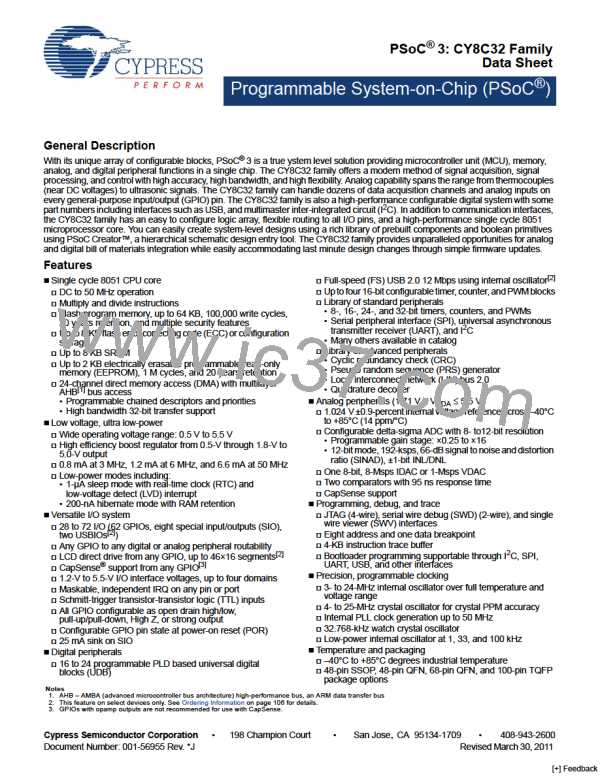PSoC® 3: CY8C32 Family
Data Sheet
4.4.4.5 Scatter Gather DMA
4.5 Interrupt Controller
In the case of scatter gather DMA, there are multiple
The interrupt controller provides a mechanism for hardware
resources to change program execution to a new address,
independent of the current task being executed by the main
code. The interrupt controller provides enhanced features not
found on original 8051 interrupt controllers:
noncontiguous sources or destinations that are required to
effectively carry out an overall DMA transaction. For example, a
packet may need to be transmitted off of the device and the
packet elements, including the header, payload, and trailer, exist
in various noncontiguous locations in memory. Scatter gather
DMA allows the segments to be concatenated together by using
multiple TDs in a chain. The chain gathers the data from the
multiple locations. A similar concept applies for the reception of
data onto the device. Certain parts of the received data may need
to be scattered to various locations in memory for software
processing convenience. Each TD in the chain specifies the
location for each discrete element in the chain.
Thirty two interrupt vectors
Jumps directly to ISR anywhere in code space with dynamic
vector addresses
Multiple sources for each vector
Flexible interrupt to vector matching
Each interrupt vector is independently enabled or disabled
4.4.4.6 Packet Queuing DMA
Each interrupt can be dynamically assigned one of eight
priorities
Packet queuing DMA is similar to scatter gather DMA but
specifically refers to packet protocols. With these protocols,
there may be separate configuration, data, and status phases
associated with sending or receiving a packet.
Eight level nestable interrupts
Multiple I/O interrupt vectors
Software can send interrupts
Software can clear pending interrupts
For instance, to transmit a packet, a memory mapped
configuration register can be written inside a peripheral,
specifying the overall length of the ensuing data phase. The CPU
can set up this configuration information anywhere in system
memory and copy it with a simple TD to the peripheral. After the
configuration phase, a data phase TD (or a series of data phase
TDs) can begin (potentially using scatter gather). When the data
phase TD(s) finish, a status phase TD can be invoked that reads
some memory mapped status information from the peripheral
and copies it to a location in system memory specified by the
CPU for later inspection. Multiple sets of configuration, data, and
status phase “subchains” can be strung together to create larger
chains that transmit multiple packets in this way. A similar
concept exists in the opposite direction to receive the packets.
When an interrupt is pending, the current instruction is
completed and the program counter is pushed onto the stack.
Code execution then jumps to the program address provided by
the vector. After the ISR is completed, a RETI instruction is
executed and returns execution to the instruction following the
previously interrupted instruction. To do this the RETI instruction
pops the program counter from the stack.
If the same priority level is assigned to two or more interrupts,
the interrupt with the lower vector number is executed first. Each
interrupt vector may choose from three interrupt sources: Fixed
Function, DMA, and UDB. The fixed function interrupts are direct
connections to the most common interrupt sources and provide
the lowest resource cost connection. The DMA interrupt sources
provide direct connections to the two DMA interrupt sources
provided per DMA channel. The third interrupt source for vectors
is from the UDB digital routing array. This allows any digital signal
available to the UDB array to be used as an interrupt source.
Fixed function interrupts and all interrupt sources may be routed
to any interrupt vector using the UDB interrupt source
connections.
4.4.4.7 Nested DMA
One TD may modify another TD, as the TD configuration space
is memory mapped similar to any other peripheral. For example,
a first TD loads a second TD’s configuration and then calls the
second TD. The second TD moves data as required by the
application. When complete, the second TD calls the first TD,
which again updates the second TD’s configuration. This
process repeats as often as necessary.
Figure 4-2 on page 19 represents typical flow of events when an
interrupt triggered. Figure 4-3 on page 20 shows the interrupt
structure and priority polling.
Document Number: 001-56955 Rev. *J
Page 18 of 119
[+] Feedback

 CYPRESS [ CYPRESS ]
CYPRESS [ CYPRESS ]